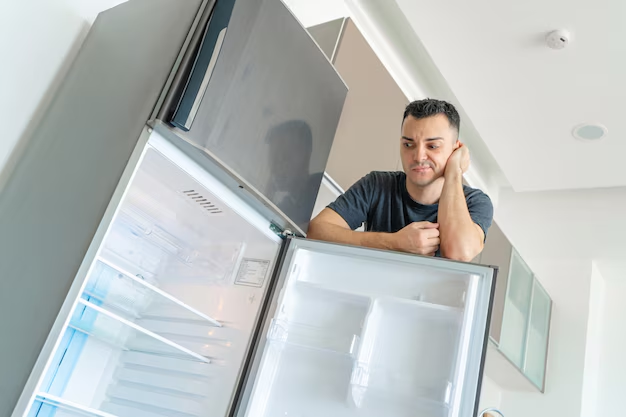How Long Can Your Food Last in the Fridge Without Power? A Practical Guide
Imagine it's a stormy night, and suddenly the power cuts out. Panic might set in when you realize all your refrigerated and frozen food is at risk. How long will it last before it's unsafe to eat? Here's a comprehensive look into strategies and insights about how long food can safely remain fresh in your refrigerator during a power outage.
🌟 Understanding the Impact of Power Outages on Food
First, it’s important to understand why food spoils without constant refrigeration. Refrigerators work by slowing down bacterial and fungal growth; once the temperature rises, these microorganisms can multiply rapidly, compromising your food's safety and quality.
Typical Refrigerator and Freezer Timeframes
- Refrigerator: Generally, a refrigerator can keep food safe for up to 4 hours after losing power, assuming the door remains closed.
- Freezer: A full freezer can keep its temperature for about 48 hours (24 hours if half-full) if the door remains shut.
🧊 The Role of Insulation and Ambient Temperature
Both the efficiency of your refrigerator's insulation and the ambient temperature can significantly impact how long your food remains safe. Cool environments may provide an edge, giving you a bit more time.
Tactics for Retaining Cold in Your Refrigerator
- Keep Doors Closed: Every time you open the fridge, cold air escapes. Keeping the door shut as much as possible maintains the internal temperature.
- Use Ice Packs: Placing ice packs or bags of ice inside can help maintain a cooler temperature for longer periods.
- Move Perishables to the Freezer: If the freezer is still relatively cool, move highly perishable items like dairy or meat from the refrigerator into the freezer.
🚨 Signs Your Food Has Gone Bad
Knowing when to discard food is crucial to avoid foodborne illnesses.
Smell and Appearance Signals
- Spoiled Odor: If a food item smells off, sour, or otherwise bad, it’s best to err on the side of caution and dispose of it.
- Texture and Color Change: Slime, mold, or discoloration can indicate spoilage.
- Bubbling in Sauces or Liquids: This might suggest fermentation has occurred.
Non-Visible Risks
Even if food doesn’t show physical signs of spoilage, the presence of harmful bacteria like Salmonella or E. coli might still be a risk. When in doubt, throw it out!
🔍 The Food Item Breakdown: What's Safe and What's Not
Let's delve into specifics about various food categories during a power outage.
Dairy Products
- Milk: At room temperature, milk is highly perishable. If unrefrigerated for more than 2 hours, consider discarding.
- Cheese: Hard cheeses like cheddar can last longer without refrigeration, but softer cheeses should be monitored closely.
Meats and Seafood
- Raw Meat: Should ideally be cooked or refrozen within 1-2 hours of being unrefrigerated.
- Cooked Meat: Like raw meat, cooked products need immediate attention after a few hours without cooling.
- Seafood: Like dairy, seafood is typically sensitive to temperature changes and should be scrutinized.
Fruits and Vegetables
- Some fruits, like apples and oranges, are more forgiving and can last extended periods without refrigeration.
- Leafy greens and berries are more prone to wilting or spoiling once temperatures rise.
Leftover and Pre-cooked Meals
- Due to the potential for bacterial growth, these are best kept under refrigeration. If left at higher temperatures for over 2 hours, discard them.
✅ Quick Reference Summary: Keep it Safe!
Here's a handy visual guide to keep track of your perishables during a power outage:
| Food Item | Safe Time Without Power | Actions |
|---|---|---|
| Milk | Up to 4 hours | Use, cook, or discard after cut-off |
| Hard Cheese | Several hours | Ideal for longer periods; check odor |
| Raw Meat | 1-2 hours | Cook or refreeze soon after outage |
| Cooked Meat | Similar to raw | Same guidelines apply |
| Seafood | 1-2 hours | Preferably consume quickly |
| Apples/Oranges | Longer periods | Safe without immediate refrigeration |
| Leafy Greens | Few hours | Check for wilting or spoilage signs |
| Leftovers | 1-2 hours | Priority use during powers outage |
🍳 Preparation and Preventative Tips
Sometimes anticipation is key to successfully managing an unexpected situation. Here are steps you can take to prepare and react proactively before and during a power outage:
Before an Outage
- Freeze Water Jugs: Pre-frozen water jugs or ice packs help maintain low temperatures in freezers.
- Organize Food: Place frequently used items in an accessible spot so you can retrieve them quickly.
During an Outage
- Check Temperature: If possible, use a thermometer to verify fridge and freezer temperatures remain below the safe threshold.
- Declare a Use-First Zone: Identify foods that must be used quickly upon air exposure and place them in designated areas.
🌍 Conclusion
The key to managing food safety during a power outage lies in preparation and quick decision-making. By understanding the guidelines on how long specific food types can safely sit unrefrigerated and using practical strategies to retain cool temperatures, you can minimize potential waste and uphold safety standards for you and your family. Remember, the mantra of "when in doubt, throw it out" can be a lifesaver in these situations. Use this guide to keep your household informed and ready for the next inevitable power hiccup. Stay safe and smart with efficient food storage practices!
